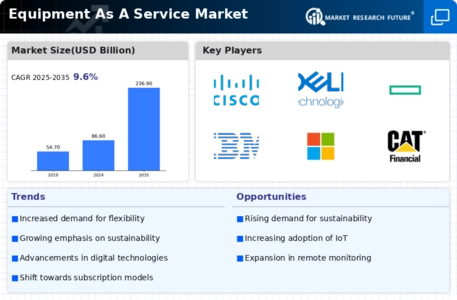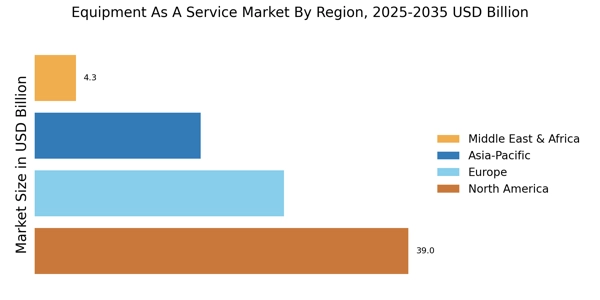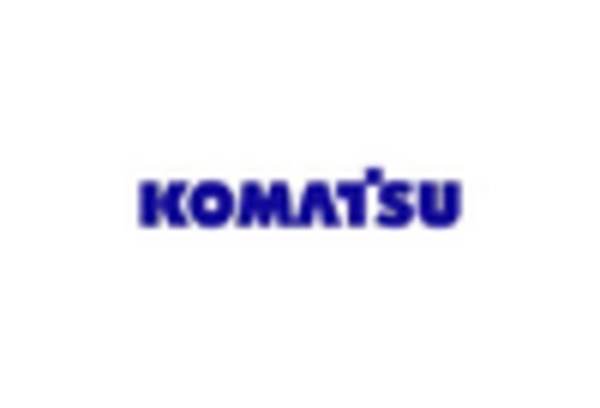Customization and Tailored Solutions
Customization and tailored solutions are becoming increasingly important in the Equipment As A Service Market. Businesses are recognizing that one-size-fits-all approaches do not meet their unique operational needs. The Equipment As A Service model allows for greater flexibility in terms of equipment selection, service levels, and contract terms. This adaptability enables companies to create solutions that align closely with their specific requirements, enhancing overall satisfaction and performance. As organizations seek to optimize their operations, the demand for customized equipment services is likely to rise. Market analysis indicates that companies offering tailored solutions can achieve higher customer retention rates, further propelling the growth of the Equipment As A Service Market.
Cost Efficiency and Financial Flexibility
The Equipment As A Service Market is increasingly driven by the need for cost efficiency and financial flexibility among businesses. Companies are seeking ways to minimize capital expenditures while maximizing operational efficiency. By adopting an Equipment As A Service model, organizations can convert large upfront costs into manageable subscription-based payments. This shift allows for better cash flow management and enables companies to allocate resources more effectively. According to recent data, businesses that have transitioned to this model report a reduction in equipment-related costs by up to 30%. This financial advantage is particularly appealing to small and medium-sized enterprises, which often face budget constraints. As a result, the Equipment As A Service Market is likely to see continued growth as more companies recognize the benefits of this financial model.
Increased Focus on Operational Efficiency
An increased focus on operational efficiency is driving the Equipment As A Service Market. Businesses are continually seeking ways to streamline operations and enhance productivity. The Equipment As A Service model allows companies to access the latest equipment without the burden of ownership, enabling them to focus on their core competencies. This model also facilitates quicker access to advanced technologies, which can lead to improved operational workflows. Data suggests that organizations utilizing Equipment As A Service can achieve up to a 25% improvement in productivity. As companies strive to remain competitive in a rapidly evolving market, the Equipment As A Service Market is expected to grow as more businesses recognize the value of operational efficiency.
Technological Advancements and IoT Integration
Technological advancements, particularly in the realm of the Internet of Things (IoT), are significantly influencing the Equipment As A Service Market. The integration of IoT technology allows for real-time monitoring and predictive maintenance of equipment, enhancing operational efficiency. Companies can now track equipment performance, usage patterns, and maintenance needs remotely, which reduces downtime and extends the lifespan of assets. This capability not only improves service delivery but also fosters a proactive approach to equipment management. As per industry estimates, the incorporation of IoT in equipment services can lead to a 20% increase in operational efficiency. Consequently, the Equipment As A Service Market is poised for expansion as businesses increasingly adopt these advanced technologies to optimize their operations.
Growing Demand for Sustainability and Eco-Friendly Solutions
The growing emphasis on sustainability and eco-friendly solutions is a pivotal driver for the Equipment As A Service Market. Organizations are under increasing pressure to reduce their carbon footprint and adopt sustainable practices. The Equipment As A Service model aligns with these goals by promoting the efficient use of resources and reducing waste. By leasing equipment rather than purchasing it outright, companies can ensure that they are using the latest, most energy-efficient models, which often have a lower environmental impact. Recent studies indicate that businesses adopting sustainable practices can enhance their brand reputation and customer loyalty. As sustainability becomes a core business strategy, the Equipment As A Service Market is likely to experience heightened demand as companies seek environmentally responsible solutions.


















Leave a Comment